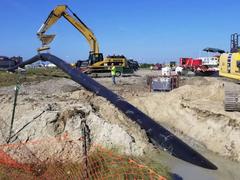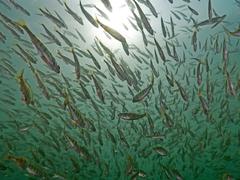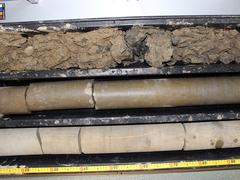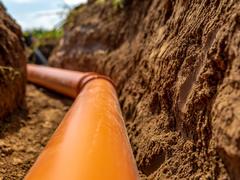- Info
Drilling fluids: back to basics
With advances in HDD technology and equipment it is easy to forget the basics – particularly when dealing with the fundamentals of the testing and concepts used in HDD drilling fluids.
It does not matter who produced the bentonite being used on a particular job, they can all be evaluated using the same concepts and tests. Barrel yield, viscosity, gel strength and fluid loss are terms used in the industry daily. Understanding and using these concepts pays dividends when devising and evaluating drilling fluids and fluid programs.
Bentonite is montmorillonite clay. There are two principal varieties of montmorillonite: sodium and calcium. Sodium bentonite has a greater ability to adsorb water, creating more viscosity with less bentonite. The solids content of a sodium based bentonite will always be lower than its calcium counterpart. The typical solids content of a sodium bentonite based drilling fluid is less than four per cent, with the balance being water.
Often drilling fluid suppliers talk about the barrel yield of their material, yet people do not understand this basic concept from the oil field. A short tonne (909 kg) of bentonite is hydrated with deionised (DI) water to a Marsh funnel viscosity of 36 seconds per quart. The resulting fluid is measured in oil field barrels - roughly 164 litres.
A 240 barrel yield product would produce approximately 40,000 litres of mud, while a 150 barrel yield mud would produce 25,000 litres - the higher the barrel yield of the mud the less bentonite required to produce a given viscosity. It is important to remember that these results are achieved using DI water - the use of poor quality water can and will have a significant impact on the amount of material used in the field. Contaminants such as calcium or chlorides will impact barrel yield.
Viscosity is another term used in the industry daily. It is simply resistance to flow and is measured using a Marsh cup and funnel. This simple test takes very little time and is important to do. Techniques such as visual inspection and feeling mud will not produce accurate results. Water flows at a rate of about 27 seconds per quart, while the fluids used in HDD typically range from the low forties to the high sixties.
Viscosity should always be geared to soil conditions. Generally speaking, a drilling fluid in clay should be in the low forties while fluids used in sand are much higher, often in the mid to high sixties. The Marsh cup and funnel is an inexpensive piece of equipment and is simple to use. With a finger over the bottom of the funnel it is filled to the bottom of the screen, then the cup is placed under the funnel and the finger at the bottom of the funnel is removed. The time taken for the fluid to touch the one quart mark is then recorded. Any solid material remaining on the screen indicates the mixing process is not finished and the bentonite is not fully hydrated.
Gel strength is a concept often misunderstood. It is simply the ability of a drilling fluid to suspend cuttings while the fluid is at rest. Bentonite crystals interact with each other to form a matrix which suspends drilled solids. Gels are measured with a viscometer at ten seconds and ten minutes. A gel that builds substantially over time is termed progressive.
Figure 1: Fluid loss test of a HDD drilling fluid with low fluid loss. Note the thickness of the filter cake. This filter cake is thin and tough and does not decrease the annular space that the drilling fluid travels in (Photo: Trenchless Australasia). The focus is on developing gels that build rapidly to support cuttings, but do not increase dramatically over time. These are termed fragile gels. The reason for this is simple. When a mud pump is turned back on, the gels need to be broken to get the circulation going. A highly progressive gel in an unconsolidated soil condition on a long bore can result in a frac-out.
Fluid loss is one of the least understood but most important concepts in drilling. Simply put, it is the loss of the water phase of the drilling fluid into the surrounding soil. It is measured with a filter press. A fluid with a high fluid loss will form a thick, mushy filter cake on the side of the bore hole. A very thick filter cake will decrease the amount of annular space available for the drilling fluid to flow. This pressurises the hole and can cause a frac-out.
Figure 2: Fluid loss test of a drilling fluid with very high fluid loss. Note the thickness of the filter cake. Adding drilled solids would also increase the thickness of the filter cake. As you can see this has a dramatic effect on the annular space through which our drilling fluid passes. This cake is soft and mushy to the touch (Photo: Trenchless Australasia). High fluid loss also wets the area around the bore hole, and in sand or cobble conditions this can cause your hole to collapse. Keeping the hole open often has more to do with fluid loss than viscosity. A fluid with a low fluid loss will have a thin tough filter cake. This maximises the space available for the fluid to flow and limits the loss of water from the drilling fluid into the formation. Dropping two samples of drilling mud on some sand illustrates this point. The fluid with the higher fluid loss will have a larger wet ring on the sand, and the remaining fluid will quickly be much thicker.
There are some basic techniques and considerations that also come into play when actually mixing a drilling fluid. As already stated, drilling fluids are roughly 96 per cent water – which should serve to highlight the importance of water quality.
A test for water hardness or calcium content will show whether soda ash will need to be added to make-up water. Each brand of bentonite has different tolerances for total hardness, so the point at which soda ash should be added should always be checked with the bentonite supplier.
The supplier can also provide information on the preferred pH range of the material. Each bentonite has a pH at which it is most effective. To achieve this, adding soda ash will increase the pH while treating out calcium. Simple pH test strips are dipped and colour matched to determine the pH of the water. Contaminants such as calcium or chlorides not only decrease the yield of the product, but more importantly have a significant negative impact on fluid loss.
The bentonite should be added to the water via a high shear mixer to build viscosity, and the checked with a Marsh cup and funnel. After adding the bentonite, polymers should be added as necessary. Each family of polymers has different characteristics, things they do well and things they are sensitive to – and the characteristics of any polymer should always be well-known before use. Does it build viscosity? Control fluid loss? Increase gels, and if so are they progressive? Selecting the appropriate polymers for each HDD job will help control fluid costs. Once the polymer is fully mixed the finished viscosity should be checked to ensure it is appropriate to the soil conditions.
More News and Articles

Die Entwässerungssysteme unserer Städte sind ein wesentlicher Bestandteil des kommunalen Anlagevermögens. Die große Zukunftsaufgabe, …

Die Entwässerungssysteme unserer Städte sind ein wesentlicher Bestandteil des kommunalen Anlagevermögens. Die große Zukunftsaufgabe, vor der viele Kommunen …

ITpipes announced it has secured $20 million in equity financing from Trilogy Search Partners and Miramar Equity Partners.
Known for its trusted and user-friendly platform, ITpipes …

With deep sadness we announce the loss of our founder and partner Prof Dr Dietrich Stein at the age of 85.
Engineers around the globe are thankful for his dedication to the inventions in the fields of sewers, …

PPI’s MAB-11-2024 Covers HDPE Water Pipelines Up to 60-in. Diameter and 10,000-ft Long Pulls
Developed by the Municipal Advisory Board (MAB) – and published with the help of the members of the …

Mass deployment of connected leak loggers is being made possible by the latest technology, writes Tony Gwynne, global leakage solutions director, Ovarro
Water companies in England and Wales are …

The innovative customer service platform Kraken has made a successful transfer from energy to water. Ahead of their presentation at UKWIR’s annual conference, Portsmouth Water chief executive …

Researchers at Eawag and the Swiss Data Science Center have trained AI algorithms with a comprehensive ecotoxicological dataset. Now their machine learning models can predict how toxic chemicals are …

Pipe renewal in Brazil
How do you stop water loss through leaks in old pipe systems without major environmental impacts and restrictions? The answer: with trenchless technology, or more precisely …

In a recently launched project, the aquatic research institute Eawag is investigating how the use of borehole thermal energy storage (BTES) affects the surrounding soil, the groundwater …

Watercare has successfully finished the final connection on the East Coast Bays link sewer at Windsor Park in New Zealand.
Much of the East Coast Bays sewer link was installed using horizontal directional …

Cities need to become more sustainable and use their water resources more efficiently. Managing water in local small-scale cycles is one possible solution. A new white paper by Eawag, the University …


